Whether your current strategy isn’t bringing the ROI you expected, or if you’re working on developing a brand new social strategy, this article will guide you in creating a plan for your social media marketing.
The first step is identifying your goals with social media. Why is your business on social media to begin with and what platforms do you use? What messaging do you want to push and why? You may be looking to generate new leads and sales, or boost engagement in the local community. Maybe, you’re looking to drive more people to your website. Or, you want people to check out a new product you just unveiled. It’s key to start with identifying your objective and purpose before you dive into the strategy.
Now, how will you measure when your goals are achieved or missed? Let’s talk about KPI’s with social media marketing. Instagram and Facebook Business offer an array of analytics to track how your posts perform, including impressions, clicks, shares, and product shopping button clicks. Here’s a helpful breakdown from Sprout Social on how to measure your KPI’s.
Awareness: Impressions, reach and follower count
Engagement: Likes, comments, shares, clicks and overall engagement rate
Conversion: Social traffic, link clicks, product button clicks on shopping content
Customer care: Response time, resolution rate, brand sentiment
Remember to keep your audience in mind when re-evaluating your social strategy. Who is your target audience? What are their needs and desires? Where do they spend time online? Collect data on your target audience before you begin shaping your content strategy. This way, you can be sure you’re posting content your target demographic will identify with.
Honing in on brand voice and values is just as important as keeping your audience in mind when you create content. Be true to who you are and allow the voice of your business to come through in all of your content. How do you want your business to look, feel, and sound on social? What types of content can you share to support your goals and objectives? How will each social platform vary in terms of the types of content you plan to deliver? What stories do you need to tell and what will make people listen?
It’s worth checking out your competition to see how others in your industry are setting the bar. What value do you offer that they don’t? What do you see others doing on social that you either like or dislike?
Now, it’s time to consider the details of your content strategy in terms of copy, branding, and content type. Whether you’re sharing still images, carousels, videos, stories, reels, or TikTok videos, your brand voice needs to come out, no matter what. Consider a mix of content types depending on the platform.
Planning your content is the next step. Using a scheduling tool or a calendar planner to map out content will help you ensure you have enough interesting, valuable, and relevant content to share throughout the month. Maybe posting every day is too much for your business and you just want to post a few times a week across different platforms. Consider the frequency of your posts and where your audience spends their time.
A strong engagement strategy will help you engage your audience as your content rolls out. Be sure to keep up to date with comments, DMs, shares, and likes to see how your content performs. Always respond to comments and DMs in a timely manner and remember to keep an eye out for any negative comments. Handle them with grace and maturity, as reputation management on social is key for brands.
Now that you have a thoughtful strategy in place, it’s crucial to measure your success and see how your social campaigns perform. What’s working and what’s not working? How can you pivot for success? Check in with weekly analytics to see which posts are resonating with your audience the most. Keep your goals, objectives, and KPI’s in mind when analyzing your performance. For example, getting a lot of likes may not be an indicator of success if your goal is to drive more people to your website.
Continue to revisit your strategy and adjust as needed. This will be an ongoing process for your brand, so keep an open mind and stay flexible, as new trends are always emerging.















